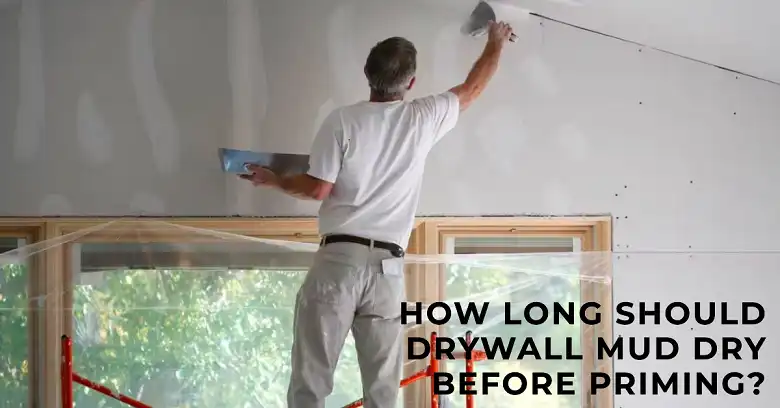How Long Should Drywall Mud Dry Before Priming?

Drywall mud, also known as joint compound, is a crucial component in creating smooth, seamless walls in construction and home improvement projects. It’s used to fill gaps, cover seams, and create a uniform surface ready for painting. However, one of the most common questions that arise during this process is: how long should drywall mud dry before priming?
The short answer is that drywall mud typically needs 24 to 48 hours to dry completely before priming. However, this timeframe can vary significantly based on several factors, including the type of mud used, environmental conditions, and application thickness.
Proper drying is essential for achieving a professional-looking finish and ensuring the longevity of your paint job. Rushing this process can lead to severe consequences, including peeling paint, unsightly blisters, and even mold growth. In this article, we’ll explore the intricacies of drywall mud drying times and provide you with all the information you need to achieve perfect results.
Types of Drywall Mud and Their Drying Times
Joint Compound
Joint compound comes in two main varieties:
- Setting type (powder mix): This type of compound sets through a chemical reaction and typically dries faster than pre-mixed varieties.
- Pre-mixed all-purpose: This ready-to-use compound is versatile but generally takes longer to dry.
Taping Compound
Specifically designed for taping drywall seams, this compound has strong adhesive properties but may take longer to dry due to its thickness.
Lightweight Mud
Ideal for skim coats and finishing touches, lightweight mud has a smoother texture and tends to dry faster than standard joint compounds.
To help you understand the drying times for different types of drywall mud, here’s a comparison table showing approximate drying times under ideal conditions (70°F, 50% humidity):
| Mud Type | Thin Application (Screw Holes) | Medium Application (Taped Seams) | Thick Application (Skim Coats) |
| Setting Type | 30 minutes – 2 hours | 2 – 4 hours | 4 – 8 hours |
| Pre-mixed All-Purpose | 4 – 8 hours | 12 – 24 hours | 24 – 48 hours |
| Taping Compound | 6 – 12 hours | 24 – 36 hours | 36 – 48 hours |
| Lightweight Mud | 2 – 4 hours | 8 – 16 hours | 16 – 24 hours |
General Drying Time Guidelines
While the table above provides a good starting point, it’s crucial to understand that these are general guidelines. The actual drying time can vary based on several factors, which we’ll discuss in the next section.
As a rule of thumb, you should wait at least 24 hours before priming, even if the mud appears dry. For thicker applications or in less ideal conditions, waiting 48 hours or more is often necessary.
It’s important to note that regardless of the estimated drying time, you should always check for dryness before proceeding to prime. Here are some methods to determine if your drywall mud is dry:
- Touch test: The mud should feel hard and cool to the touch, not soft or damp.
- Visual indicators: Look for an even color across the surface. Darker spots may indicate moisture.
- Color change: Most drywall mud lightens as it dries.
- Moisture meter: For the most accurate results, use a moisture meter. The ideal moisture content for drywall before priming should be below 15%.
What Affects Drywall Mud Drying Time
Humidity
Humidity plays a significant role in drying time. High humidity levels can dramatically slow down the drying process. In environments with humidity levels above 50%, drying times can increase by 50% or more.
To combat high humidity:
- Use a dehumidifier to reduce moisture in the air
- Run air conditioning to lower humidity and temperature
- Open windows if outdoor humidity is lower than indoor
Temperature
The ideal temperature range for drying drywall mud is between 68°F and 77°F (20°C to 25°C). Temperatures outside this range can affect drying times:
- Below 50°F (10°C): Drying may take 2-3 times longer
- Above 90°F (32°C): Mud may dry too quickly, leading to cracking
Thickness of Mud Application
Thicker applications of mud take longer to dry. As a general rule:
- 1/8 inch thick: Dries in about 24 hours
- 1/4 inch thick: May take up to 48 hours
- 1/2 inch or thicker: Can take 72 hours or more
To speed up drying, apply mud in thin, multiple coats rather than one thick coat.
Ventilation and Air Circulation
Good air circulation is crucial for even and efficient drying. Poor ventilation can increase drying time by up to 50%. Use fans to improve air circulation, but avoid pointing them directly at the mud to prevent uneven drying or cracking.
Specific Drying Times for Common Scenarios
Patching Small Holes
For small holes (less than 1 inch in diameter), expect:
- Setting-type compound: 30 minutes to 2 hours
- Pre-mixed compound: 4 to 8 hours
Taping Drywall Joints
Taping joints typically requires multiple layers:
- First coat (with tape): 24 to 48 hours
- Second coat: 24 hours
- Third (finish) coat: 24 hours
Total time: 3 to 4 days for complete drying of all coats.
Skim Coating Walls
Skim coating often requires multiple thin layers:
- Each layer: 24 hours
- Total process: 2 to 3 days for 2-3 coats
Textured Finishes
Textured finishes may require additional drying time due to their thickness and potential for trapping moisture:
- Light texture: Add 12-24 hours to normal drying time
- Heavy texture: Add 24-48 hours to normal drying time
Tips for Ensuring Proper Drying
- Use dehumidifiers and fans together for optimal drying, especially in humid environments.
- Avoid using heat sources directly on the mud, as it can cause cracking.
- Stagger the application of mud on large areas to allow for proper drying before moving on.
- Check dryness regularly before priming using the methods described earlier.
- Apply mud in thin coats for faster drying and a smoother finish.
- Consider quick-drying compounds for time-sensitive projects, but be aware they can be more challenging to work with.
Why You Shouldn’t Prime too Soon
Priming before the drywall mud is completely dry can lead to several issues:
- Poor paint adhesion, resulting in peeling or flaking
- Bubbling or blistering of the paint surface
- Increased risk of mold growth due to trapped moisture
- Uneven color or sheen in the final paint job
- Cracking or shrinking of the mud as it continues to dry under the primer
These problems can be costly and time-consuming to fix, often requiring complete removal and reapplication of the mud, primer, and paint.
Kye Takeaways
The question of how long drywall mud should dry before priming doesn’t have a one-size-fits-all answer. While 24 to 48 hours is a good general guideline, factors like humidity, temperature, mud type, and application thickness can significantly impact drying times.
The key takeaways are:
- Be patient and allow sufficient drying time.
- Always check for complete dryness before priming.
- Consider environmental factors and adjust drying times accordingly.
- Use proper techniques and materials for the best results.
By following these guidelines and understanding the drying process, you’ll achieve a smooth, durable finish that will stand the test of time. Remember, in drywall finishing, patience truly is a virtue.






